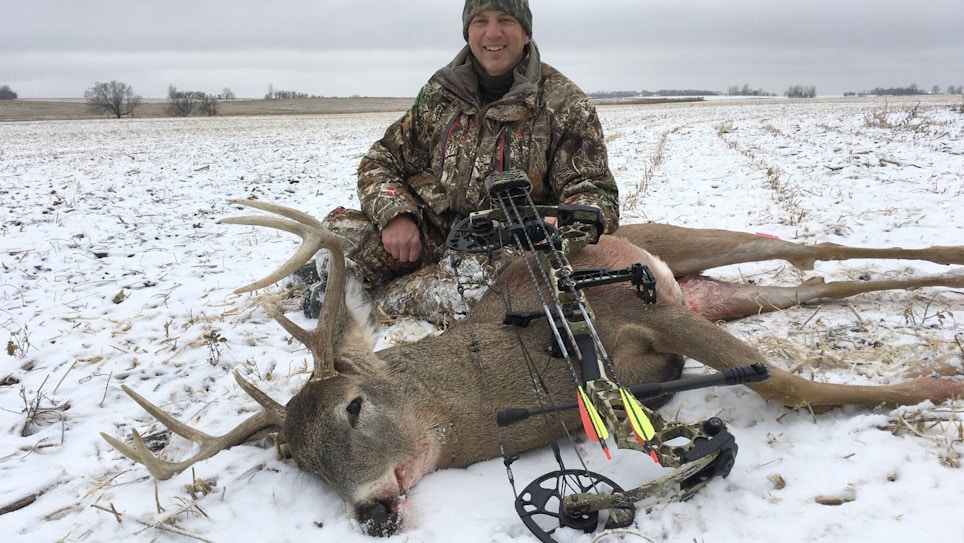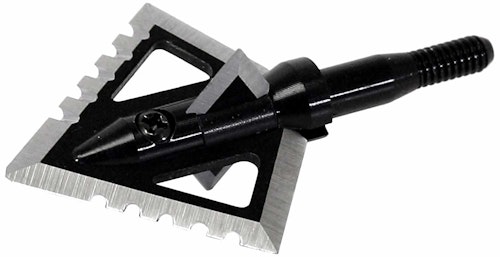Most bowhunters, especially those in farm country, spend the vast majority of their time in treestands or ground blinds (box blinds or pop-up blinds). And while a ground blind built from natural vegetation can sometimes be effective, it seems whitetails have an uncanny ability to pick off an on-the-ground hunter as he or she begins to draw their compound bow or recurve.
Over the past couple seasons, I’ve discovered a trick for drawing my compound undetected that has worked time and time again. In fact, when I’m scouting for farmland whitetails and planning my ambushes, I specifically search for spots to pull off this trick. It flat out works.
Setting the Scene
To illustrate why this trick works so well, let me provide an example. You’re walking through the woods, bow in hand, and encounter a narrow ditch filled with water. There’s no way around the ditch. You either have to step into the water (unknown depth), or jump the ditch. Because the ditch is only 3 feet wide, you make sure you have a good grip on your gear and then go for it, easily landing with both feet on the other side. No problem.
Question: Where were your eyes focused during your jump? Where you looking to either side? Of course not. Your eyes were glued to the launch point, then on the landing spot. Only after you landed did your eyes take in the surroundings.
The trick I’ve teased here works on the same principle, but instead of a ditch, I target whitetails as they encounter barbed-wire fences.
I first learned this trick while hunting a South Dakota river-bottom several years ago. My side of the fence was relatively open, which was great for decoying whitetails, but made a ground ambush nearly impossible. The problem was drawing on deer without being busted. All the thick cover was on the neighbor’s side of fence, and bucks would often cruise this cover looking for a bedded doe-in-heat during the rut. I could lure bucks to jump the fence to check out my doe decoy, but then they’d spot me drawing my bow, even though their attention was directed toward the decoy.
One time I placed my doe decoy only 20 yards from the property line, and I can vividly remember as a big buck approached the five-strand barbed-wire fence. In a moment of inspiration, I told myself: Don’t draw until he’s in the air jumping.
It worked. Sitting butt on the ground with almost no cover around me, I came to full draw and anchored as the buck’s feet hit the forest floor on my side of the fence. I killed that buck seconds later, and ever since I’ve looked for times to use this same trick.
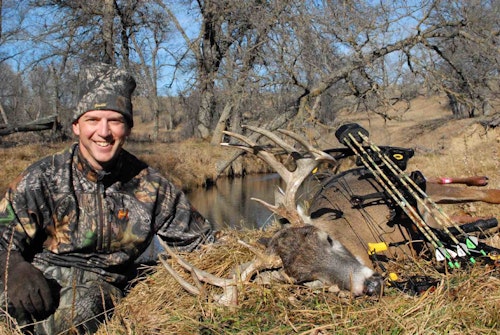
2019 Alfalfa Buck
On November 5, I crept into a skinny South Dakota shelterbelt on the edge of an alfalfa field that whitetails had been using heavily. Not wanting to mess with trying to fit a treestand into a crooked tree, and knowing whitetails wouldn’t tolerate a pop-up blind suddenly popping up on the field edge, I carried my archery gear, a stadium seat and a pruner. Before deciding on an ambush spot in the high grass of the shelterbelt, I used my binocular to examine the barbed-wire fence bordering the field. I smiled when I noticed the top strand of barbed-wire had snapped during the prior winter’s deep snow and wind, leaving a low spot in the fence between two T-posts. I figured deer would prefer jumping the fence between those posts.
I sat butt on the ground with my back supported by the Easy Chair from Sportsman’s Outdoor Products. (I’ve also had good luck with the Backwoods seat from ALPS OutdoorZ.) I faced the fence and waited. I had decent ground cover around me, and one tree I could straddle, but my head stuck above the grass, as did the top of my compound. To complicate matters, deer would be nearly facing me as they approached the fence crossing only 20 yards away.
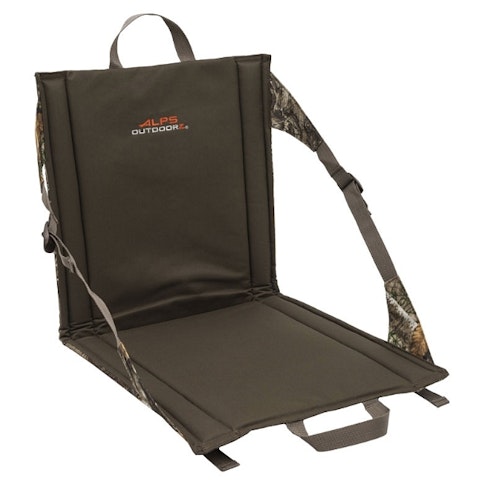
During the next hour I spotted several deer enter the alfalfa field, and while all of them didn’t cross the fence in the low spot near my ambush, a few of them did, and I hoped for the best. I wasn’t holding out for the biggest buck in the county, but I still had several days left in my annual 9-day rut vacation. I had time to be a bit choosy.
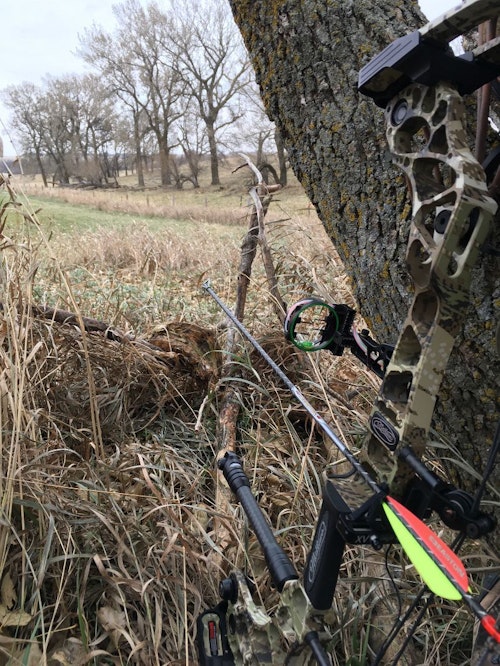
A half-hour before sunset, a wide-racked 4x4 approached the alfalfa field. He was right in line with my fence crossing spot, so I prepared for a shot. With tension on my bowstring, I assumed he’d jump the fence without breaking stride, but he didn’t. Instead, he stopped a foot from the fence and looked to the side. I waited. He took a step forward so his nose was touching the top strand of barbed-wire. Again, I placed significant tension on the bowstring but told myself to wait until he was airborne before making my big move. Still he waited.
Then, in an instant, he was in the air — and I came to full draw and found my anchor. As soon as his feet hit the green field, I found my anchor point. A split-second later I hovered my 20-yard pin over his near front leg and tracked him as he walked from right to left. Because he walking a bit too fast for my liking, I gave a loud “maaaaap” and he stopped at 17 yards and swung his head my direction. It was too late.
The 4x4 bolted from the field and tried to make it back to the river-bottom 200 yards away, but I watched him fall less than halfway there.
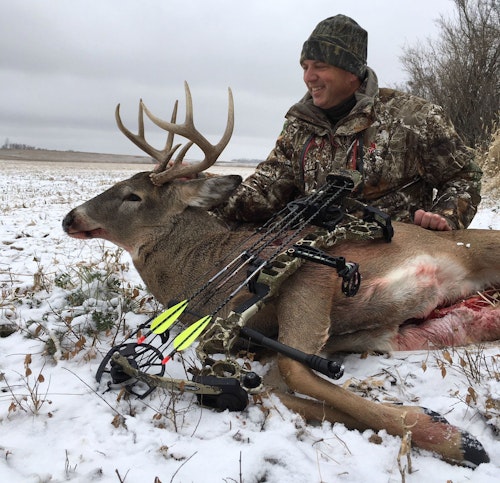
Sidebar: Maas 2019 Archery Gear List
Because I pass on any shot beyond 25 yards, I don’t worry about bow speed and flat trajectory. Instead, I choose bullet-proof gear that delivers dependable accuracy and deep penetration with little noise.
This fall during my SoDak deer vacation I matched my Mathews Triax (28.5-inch draw; 54 pounds) with Easton 5MM FMJ arrows (400 shaft; 10.2 gpi) and 125-grain, four-blade Magnus Black Hornet Ser-Razor cut-on-contact broadheads. Other gear included a Schaffer XV rest, Schaffer Opposition Air bowsight, Mathews 8-inch Flatline Stabilizer, Mathews four-arrow Arrow Web HD Quiver, and Scott Little Goose release.
One of the primary reasons behind my fixed-blade broadhead choice is I know (through experimentation and testing from shooting on the ground) that the Magnus Black Hornet Ser-Razor cuts or slips through sparse prairie grasses without affecting arrow flight or impact. Mechanical heads sometimes grab these grasses, which leads to unpredictable performance. Note: I’m not talking about shooting through several feet or yards of thick CRP grasses from the ground, but it’s comforting to know I don’t have to worry about every grass stalk with the Magnus.
